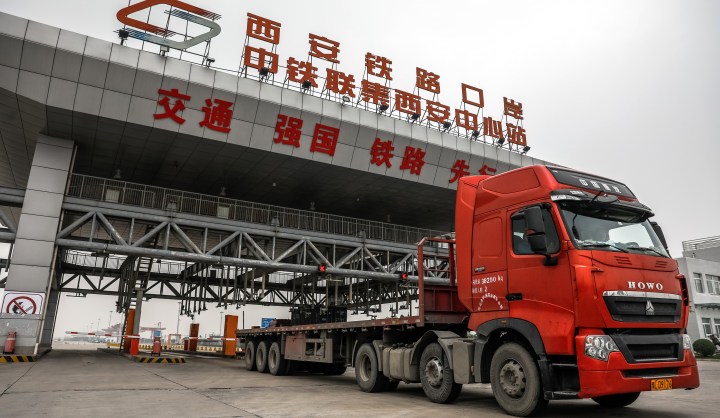Right of reply
The Belt and Road Initiative: Committed to three ‘togethers’ for five ‘connectivities’ and Win-Win Development

In response to Kevin Bloom’s piece on the Belt and Road Initiative, Chinese ambassador to South Africa Lin Songtian has requested that a transcript of his remarks about the initiative made at an event, staged by Wits University’s Africa-China Reporting Project in November, be published.
Over 2,000 years ago, the Chinese people crossed from Asia to Europe, marking the beginning of the ancient Silk Road. 600 years ago, the great Chinese navigator Zheng He led six voyages with an unbeatable fleet, into the Pacific and across the Indian Ocean, reaching as far as the eastern coast of Africa on three expeditions.
Whether it was over land or across the seas, the Chinese people had brought porcelains, teas, and silk products to the overseas, while bringing back local products. Unlike the Western colonialists, China achieved its development and got strong by our own hard work and peaceful co-operation and open development with the world, but never through war and looting.
Facing a profoundly changing world over the recent years, the peoples of the world are looking for the correct answers to two fundamental issues — Where for the world to go? And how to build a more beautiful and better world? To answer these two major issues of our times, five years ago, the Chinese President Xi Jinping put forward the Belt and Road Initiative.
The BRI advocates for three togethers, that is planning together, building together, and sharing together for five connectivities in policy, infrastructure, trade, finance, and people-to-people exchange, so as to achieve win-win co-operation for common development, and build a community of shared future for mankind. These are the principle, main purposes and objectives of the BRI.
It is easy to see that the BRI is an initiative with distinct Chinese features, but also bears the unique characteristics of our times. It is completely different from the Western colonialism and the Marshall Plan.
The BRI focuses on economic development and does not engage in the export of politics. It aims to address the bottleneck issues that restrain economic and social development to build five connectivities for common development among the participating countries. The BRI does not export ideologies, does not attach political strings, and does not seek the politics of a small circle.
The BRI is committed to open co-operation and rejects protectionism. There are no geographical or ideological barriers to participate in the BRI. Any country or region is welcome to join, as long as they agree with and follow the principle of “three together” and commit themselves to building “five connectivities”. In the BRI co-operation, there is no coercion, no forced buying or sale, no trade protectionism, and certainly, there is no such thing called “China first” or “China only”.The BRI seeks for win-win co-operation for common development and rejects zero-sum game. The BRI aims to join efforts to enlarge the cake through an integrated economy, interconnected development and shared co-operation results, so as to achieve win-win development through complementing each others’ comparative strengths instead of the winner taking all.
The Marshall Plan is a product of the Cold War and has drawn the line based on ideology and geopolitics, resulting in man-made conflicts and division of the world into the West versus the East. Countries are grouped as either an ally or a foe. The BRI is open for all, regardless of national strength or social systems. What it strives for is to build a community of shared future for mankind by three togethers for five connectivities.
The Belt and Road Initiative begins with China but belongs to the whole world. Over the past five years, the BRI has transformed from an idea into actions and from vision into reality, producing visible and tangible results. 113 countries and 29 international organisations have signed BRI co-operation documents with China. From 2013 to 2017, China’s imports from the Belt and Road countries have registered $6.97-trillion.
The Asian Infrastructure Investment Bank (AIIB) proposed by China with $100-billion of capitalisation is open to the world for infrastructure investment financing. The AIIB has approved investment for projects worth over $5.3-billion since it started operations, and has further driven over $30-billion of public and private investment into infrastructure development. Many countries have benefited from the foreign investment brought by these projects through local jobs creation and tax revenue. The Silk Road Fund with $40-billion established by China has already supported projects totalling $80-billion.
The Addis Ababa-Djibouti Railway and the Mombasa-Nairobi Railway are already in full operation. Ethiopia has achieved a double-digit GDP growth. In Kenya, the Mombasa-Nairobi Railway has created nearly 50,000 jobs and contributed 1.5% annual GDP growth. These successful examples offer a new model for connecting the BRI with Africa’s development.
A peaceful, stable, and prosperous Africa is not only in the fundamental interests of the world, but also the shared responsibility of the international community. For Africa to achieve self-sustainable development, it must break three development bottlenecks, namely backward infrastructure, lack of professional and skilled personnel, and short of capital sources. Whoever can truly help Africa break these three bottlenecks to achieve self-sustainable development are the true friends and reliable co-operation partners of Africa.
China and Africa have always been a community with a shared future. Over the years, we have always respected each other as equals and stood together through thick and thin. In 2015, President Xi proposed the China-Africa Ten Major Co-operative Plans, and in 2018, he put forward new Eight Major Initiatives together with $60-billion of financial support respectively, with an only aim to support Africa to break the three bottlenecks to achieve industrialisation and agricultural modernisation.
Guided by the principle of three TOGETHERS, China is ready to work with Africa to synergise the BRI with African development strategies for five CONNECTIVITIES. We will fully implement the Eight Major Initiatives to support African countries to develop five networks of railways, highways, power grids, air transport, and telecommunication to promote African industrialisation, agricultural modernisation, urbanisation, and digitalisation.
To connect the BRI with Africa facing two major challenges. First, there is a lack of full understanding of the BRI in Africa. What is the principle and concept of the BRI and how to connect the BRI with Africa and benefit from it? Second, some people and countries in the West don’t like and are fearful to see China supporting African countries to achieve independence politically and economically. As a result, they will never cease fabricating and playing up stories of so-called “Chinese neocolonialism”, “debt trap”, “lack of investment transparency” and so on. But the truth will always prevail. The African people are wise and mature enough to make their own and correct conclusion based on facts.
As the comprehensive strategic partner, both China and South Africa are playing growing important roles in the world, and maintain close co-operation across four major platforms, including FOCAC, BRICS, BRI, and South-South co-operation. With rich resources, superb location and better development foundation and conditions, South Africa was among the first African countries to sign the BRI MOU with China. China is ready to work together with South Africa for being a BRI pilot country in Africa, to show the success to the rest of Africa and beyond.
I am full of confidence for the bright prospect for China-South Africa and China-Africa BRI co-operation to achieve win-win development. Let us work together for common prosperity. DM
Lin Songtian is Ambassador of China to South Africa.



















 Become an Insider
Become an Insider